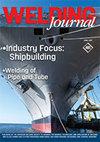数据挖掘机器人GMAW焊接质量的异构测量系统
IF 1.4
3区 材料科学
Q2 METALLURGY & METALLURGICAL ENGINEERING
引用次数: 0
摘要
在机器人焊接过程中,可以收集到多个异构数据流。为了获得对焊接过程的系统理解,这些数据流必须精确而准确地组合在一起,特别是如果我们的目标是开发在线焊接质量评估。在基于时间和空间的数据之间建立对应关系是一项非常重要的工作。本文介绍了一种数据收集系统,该系统采用一种新颖的方法,在机器人气体金属弧焊的多个数据源之间建立对应关系,以进行客观的质量评估。首先,焊接过程数据和最终焊缝之间的对应需要时间同步和空间对齐。其次,开发了一种客观的焊缝质量提取技术,该技术以1mm的线性焊缝行程为分辨率分配定量测量,以评估焊缝质量。具体而言,除了开发一种客观焊缝轮廓评估方法外,我们还开发了一种客观分析亚表面孔隙率发生的射线照相数据,以评估缺陷并演示如何客观量化表面孔隙率的发生。虽然本文的某些方面已经由其他研究单独解决,但本文提出了一种针对各种焊接数据类型的综合方法,并开发了客观的焊接质量指标,可用于机器人焊接焊接质量的机器学习。本文章由计算机程序翻译,如有差异,请以英文原文为准。
Heterogeneous Measurement System for Data Mining Robotic GMAW Weld Quality
During robotic welding, several streams of heterogeneous data can be collected. To gain a systemic understanding of the welding process, these data streams have to be combined precisely and accurately, especially if our goal is to develop online weld quality assessments. Establishing correspondence among temporal and spatially based data is a nontrivial effort. This article presents a data collection system using a novel methodology for establishing correspondence across multiple data sources of robotic gas metal arc welding for objective quality assessment. First, correspondence between the weld process data and the resulting weld required time synchronization and spatial alignment. Second, an objective weld quality extraction technique that assigns quantitative measures at a resolution of 1 mm of linear weld travel was developed to evaluate weld quality. Specifically, in addition to developing a method for objective weld profile assessment, we developed an objective analysis of radiographic data for the occurrence of subsurface porosity to assess defects and demonstrate how to objectively quantify the occurrence of surface porosity. While some aspects of this paper have been addressed individually and separately by other research, this paper presents an integrated approach to these operations for a wide variety of weld data types and develops objective weld quality metrics that can be used for machine learning of weld quality for robotic welding.
求助全文
通过发布文献求助,成功后即可免费获取论文全文。
去求助
来源期刊

Welding Journal
工程技术-冶金工程
CiteScore
3.00
自引率
0.00%
发文量
23
审稿时长
3 months
期刊介绍:
The Welding Journal has been published continually since 1922 — an unmatched link to all issues and advancements concerning metal fabrication and construction.
Each month the Welding Journal delivers news of the welding and metal fabricating industry. Stay informed on the latest products, trends, technology and events via in-depth articles, full-color photos and illustrations, and timely, cost-saving advice. Also featured are articles and supplements on related activities, such as testing and inspection, maintenance and repair, design, training, personal safety, and brazing and soldering.
 求助内容:
求助内容: 应助结果提醒方式:
应助结果提醒方式:


